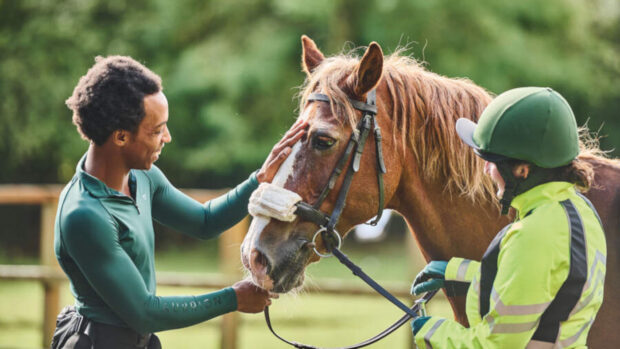A rider who had essentially retired her horse owing to his “dangerous” behaviour, for which no one could find a cause, is back in the saddle after a bean was removed from his sheath.
Wendy Chriss’s thoroughbred gelding Scooby had been out of work for the best part of four years but despite the best efforts of a vet, saddler and physio, no cause for his issues could be found – until Tracey “the Bean Queen” Freeman paid a visit.
Wendy told H&H she first realised something was wrong when she tried to saddle Scooby in 2014, and he started “shaking uncontrollably”.
She had his saddle and back checked but nothing could be found.
“Every time I tried to get on, he’d shoot backwards,” Wendy said. “It was quite scary, and I’d never been scared before. My husband told me I must be losing my bottle – then he saw it happen one day, and he said: ‘get off that horse now’.”
Wendy turned Scooby away for the winter but the next spring, he was the same. She had him scoped for ulcers to no avail, but also noticed he would continually rest his off hind leg, while weeing, and even if his left fore foot was picked up.
So the now 20-year-old gelding could not be ridden – until this year, a friend mentioned Tracey, of Sheath Cleaning UK.
“Because it costs £25, I thought I’d get all the horses done,” Wendy said. “Tracey was telling me about all the symptoms of having these beans and my daughter said: ‘That sounds like Scooby, Mum’.
“Then Tracey put her hand in and said: ‘We’ve got a big one’.

“We’ve now had him back in work two weeks and haven’t had a single problem; for £25, I can’t believe what she’s done. I’ve wasted four years and I’m gutted, but so relieved to be back on.”
Wendy wants other owners to be aware of the issue, as she said she had never heard of sheath beans in her years of owning horses.
“This story needs to get out,” she said. “How many horses are like this? I could have had him put down because he was dangerous, or he’d have been retired – but thanks to Tracey, I’ve got my horse back. I’m so pleased.”
Beans form from a build-up of smegma, which calcifies into hard lumps inside the sheath.
“They call them beans but they’re rock-hard; it must be like walking round with a big stone in your shoe, that you can’t get rid of,” she said. “I’ve had horses who had just stopped going forward, or had just gone off the job, and since I’ve taken the beans out, they’re back to their best.”
Tracey said she also wants to raise awareness of the effects beans seem to have.
“Every time I pull one out – and I must have done thousands – I look at it and think ‘oh my God, how has this horse been functioning?’” she said.
“It’s so rewarding; I’ve had people ringing me in tears saying I’ve given them their horse back; Wendy’s horse is one of many.
“It’s trying to make people aware; horses like Wendy’s could have ended up being put down but it’s lovely to see her riding again.”
You may also be interested in:

Meet the ‘Bean Queen’: why cleaning sheaths is important and the delights of the job
Horse & Hound spoke to Tracey Freeman, who makes a living cleaning sheaths across the country

Sheath cleaning — and 9 other less than pleasant jobs horse owners have to do

Subscribe to Horse & Hound magazine today – and enjoy unlimited website access all year round
For all the latest news analysis, competition reports, interviews, features and much more, don’t miss Horse & Hound magazine, on sale every Thursday.





